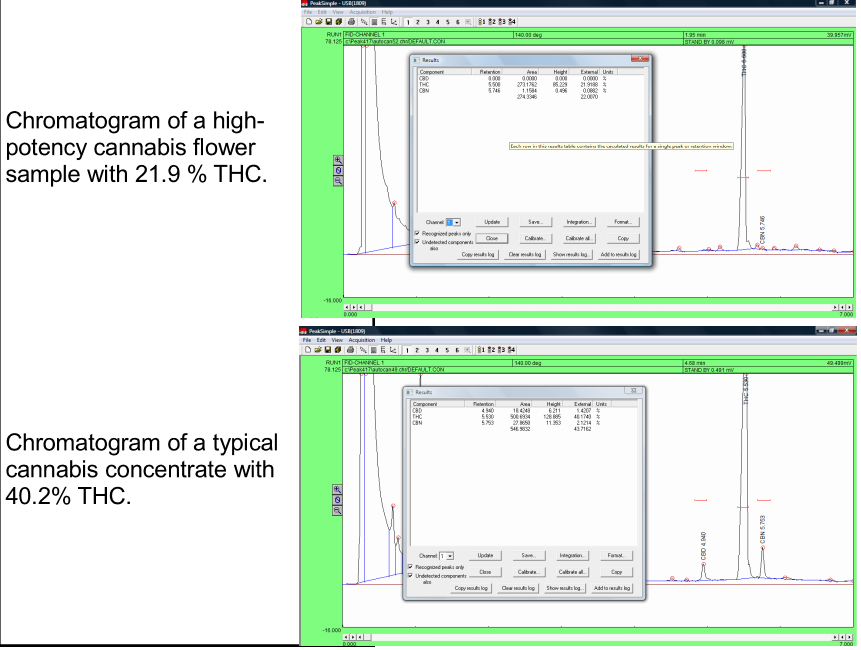Understanding CBD Oil: Proof of Potency
Previously we discussed the basics of industrial hemp. Today we’ll devil into the details of an important part of industrial hemp production when making a product called CBD oil. That step is the use of liquid chromatography.
We now have dozens of companies selling CBD oil. This material can be sourced from the seeds, stalks, leaves and flowers of industrial hemp. Or in many cases hemp stalks are all that’s used. It typically does not come from marijuana with a high CBD content. There are some exceptions like Charlotte’s Web extracts which come from the varietal.
These products are touted as CBD oil which means they are supposed to be rich in CBD, but are they? Sadly, industrial hemp is not rich in CBD. It takes many more chemical steps (and money) to concentrate the CBD from industrial hemp raw materials. Therefore, some unscrupulous firms may cut steps and costs while providing you with an inferior oil. They can do it because there is no legal definition of what CBD oil (or anything else for that matter) is supposed to be.
REQUESTING PROOF OF POTENCY
I have contacted a half-dozen large, popular, companies asking for a third-party, laboratory analysis of their CBD oil. I requested a copy of their report clearly showing the current batch analyzed (batch number), with the date that the analysis took place. The report needs to contain a breakdown of the cannabinoids by percent-usually mg%.
What you usually get from most websites is a photo of their CBD product with a label. If you can read it, the label might say CBD 17%, for example. That means that there are 170 milligrams of CBD per cc of fluid. But they can say anything they want. A label is not proof of anything. We need more than a simple label.
FOLLOWING GMP
All businesses should be doing what the below company claims to be doing.
From the US Hemp Wholesale website:
All of The US Hemp Wholesale CBD oil is manufactured under strict quality controls in an FDA-registered cGMP (FDA Current Good Manufacturing Procedures) certified facility, and is extracted utilizing Supercritical Fluid Extraction (CO2). Independent labs test each batch using high-tech liquid gas chromatography for verification of purity and concentration of CBD (cannabidiol) at various stages of production, from seed to shelf. Additional tests for yeast, molds, E. coli, coliforms, and total aerobic count are also performed for each batch, along with heavy metals testing. No chemical solvents are used in the production of these oils.
The occasional blind-test is done at SC Labs in Santa Cruz, CA, to double check that the product is as advertised.
Claims like this are pretty standard for reputable companies. In the above statement we clearly see that tests are always performed BUT WHERE ARE THE TEST RESULTS? In this particular case I looked everywhere on their site. There was no “lab test” section that I could find. Where are the so-called “blind tests?” I could not find where proof was offered anywhere.
In fairness I did not contact this particular company for proof so they may indeed offer verification upon request. But why do we need to go out of our way, waiting days for a response? It would be better if they had a section which demonstrates proof of their claims.
Like the above, Real Scientific Hemp Oil (RSHO), provides a slick product with a label batch number and concentration on the syringe. Excellent so far. What they don’t provide is proof of authenticity. That requires a copy of their third-party lab analysis.
WHAT IS THE ROLE OF THIRD PARTY TESTING?
When a company produces are product which they claim contains a certain element or chemical in it, they need to have it analyzed for concentration or potency. In this case the testing would involve a highly sophisticated instrument called a high-pressure liquid chromatography machine. It should provide % concentrations of numerous cannabinoids. The below site offers at least 8 cannabinoids for analysis on one of their sample printouts. How many different cannabinoids is up to the lab, how much the consumer wishes to pay, and the sophistication of the machine. All of them will test for the major players CBD and THC.
From the Analytical 360 website:
Analytical 360 employs High Pressure Liquid Chromatography (HPLC) technology to directly quantify the total cannabinoid content of medical cannabis. Beginning with dry-weight determination, we analyze the percentage of water contained in each sample to ensure proper preparation during the curing process. Our quantification process then identifies and measures the amount of total Cannabidiol (CBDA + CBD), Tetrahydrocannabinol (∆9THCA + ∆9THC + ∆8THC), Cannabinol (CBN), Cannabichromene (CBC) and Cannabigerol (CBGA +CBG). We also measure the Terpene content (Linalool, Myrcene, Limonene, Terpinolene, α-Pinene, β-Pinene, Humulene, Caryophyllene, and Caryophyllene oxide). These key Cannabinoids and Terpenes give cannabis many medicinal properties.[ref](http://analytical360.com/cannabis-analysis-laboratory/potency-testing) 06/15/2015[/ref]
The official, certified test is then printed up and given to the company. It might look like the below image:
The printout was produced by Analytical 360 as were the below images which are screen shots of the machine’s monitor. In the next article I’ll give you the results of my requests for laboratory evidence.


